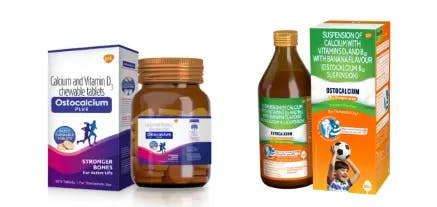Strong bones are desired by everyone yet bone health is conveniently ignored
We need our bones for every small movement. Right from pointing a simple finger, to getting up from the chair to walking. We usually take our bones for granted and only think about them when have issues such as pain or a fracture. Bones are an important part of our body and we need to take care of them.
Some interesting bone facts
Here are some bone facts you need to know
Fact 1: Bones are also made up of proteins
We all associate Calcium with strong bones and it is the major building block of the bone. However, our bones have significant amounts of a protein called ‘collagen’ too.
Fact 2: Bones are actually spongy from the inside
You might think bone is a thick chunk of mineral, but our bones actually have a remarkable structure. It is compact and strong on the outside but spongy from inside. This combination of compact bone and spongy one makes our bones strong yet not very heavy.
Fact 3: Bones help in production of blood too
Confused on how bones help in blood production? That is because inside of the bone houses bone marrow, the spongy tissue which makes blood in our body
Fact 4: Bones make for a strong enclosure for delicate organs
Our brain, heart, lungs and kidneys are all protected by our bone structure
Fact 5: Our bones undergo constant ‘maintenance work’
‘Old’ portions of the bones are constantly remodelled and replaced with a new, refreshed version.
Fact 6: Bones are our body’s mineral bank account
Our bones are the safe keeper of Calcium and phosphorus in the body. Our body needs Calcium to maintain a steady level in the blood. If we are not getting enough Calcium from food, then our body takes it from our bones.
Fact 7: The best time to invest in your bones is until 18/20 years of age!
Yes. Majority (almost 90%) of the mineral deposit in the bones happen during childhood and until 18 years for girls and 20 years for boys. In conclusion, our bones are the framework of the body which not only helps in movement but also acting like a strong protective fence to the delicate organs. This mineral storehouse for Calcium and phosphorus undergoes constant sculpting, a process that happens lifelong. Early 20s is the best time as the bone mass peaks. Many factors influence the strength of our bones. If our diet fails to provide sufficient Calcium, then our body withdraws the Calcium from the bones weakening it. Osteoporosis is the most common bone disease where the bone becomes so weak it can break or fracture easily. This can be prevented by optimizing bone health during adolescence, maintaining healthy and strong bones throughout life and healthy aging by preventing bone loss. Consuming enough Vitamin D3 and Calcium can go a long way in ensuring the health of this bone ‘bank’ remains great
References
1. Office of the Surgeon General (US). Bone Health and Osteoporosis: A Report of the Surgeon General. Rockville (MD): Office of the Surgeon General (US); 2004.
2, The Basics of Bone in Health and Disease. Available from: https:/www.ncbi.nlm.nih.gov/books/NBK45504/. Accessed on: 06 July 2020 2. The US National Library of Medicine. Red blood cell production. Available from: https:/medlineplus.gov/ency/anatomyvideos/000104.htm. Accessed on: 10 July 2020
3. National institute of arthritis and musculoskeletal and skin diseases. Bone Health for Life: Health Information Basics for You and Your Family. Available from: https:/www.bones.nih.gov/health-info/bone/bone-health/bone-health-life-health-information-basics-you-andyour-family. Accessed on: 06 July 2020
4. National institute of arthritis and musculoskeletal and skin diseases. Osteoporosis: Peak Bone Mass in Women. Available from: https:/ www.bones.nih.gov/health-info/bone/osteoporosis/bone-mass. Accessed on: 06 July 2020
5. Sunyecz JA. The use of Calcium and Vitamin D3 in the management of osteoporosis. Ther Clin Risk Manag. 2008;4(4):827-836.




